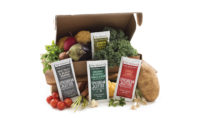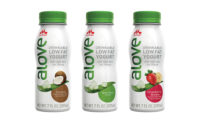Ingredient companies serving up “clean” options to their dairy-biz customers can rest assured: The ball will be in their court as we roll into 2019.
That’s because the three overriding themes most likely to drive dairy formulation in the coming year are — once again — clean labels, clean labels and more clean labels.
Milk | Cheese | Cultured | Ice Cream | Butter | Non-dairy Beverages | Ingredients | Exports
But don’t take our word for it; listen to ingredient suppliers themselves.
Advantage: great taste
“Consumers, especially dairy consumers, are demanding more from the products they purchase,” observed Pam Stauffer, global marketing programs manager, Cargill, Wayzata, Minn. “They’re scrutinizing labels, looking for short ingredient lists and recognizable ingredients.
“They want products they perceive as healthier, with functional benefits,” she added. “And they’re watching added sugar levels. But above all else, taste still reigns supreme.”
Stauffer’s observations echo the main takeaway from propriety Cargill research on consumers’ perceptions and priorities vis-à-vis dairy — particularly regarding texture, sugar reduction and clean labels. The key finding: Great taste led product purchase attributes across all dairy segments explored — yogurt, flavored milk, ice cream and dairy alternatives.
“In fact,” said Mark Fahlin, Cargill’s business development manager for dairy, “taste tends to be more important for dairy than for other food categories. That said, other attributes are influential, too, including healthy ingredients, nutritional value and ingredient quality.”
In other words, clean-label consumers want to have their ice cream cake and eat it, too. And that makes dairy formulators’ jobs that much more difficult.
“Dairy is traditionally viewed as a wholesome, pure and simple product,” said Christine Addington, senior dairy technical service specialist at Cargill. “Consumers often don’t want what they consider ‘unnecessary’ or ‘chemical-sounding’ ingredients in their dairy products. But this is challenging since many of these ingredients are highly functional in dairy systems.”
Thus, it’s the task of finding — or outright creating — solutions that bridge the label-friendly/functional divide that’s occupied ingredient suppliers for the past several years, and will keep them occupied for years to come.
Ace: sugar reduction
Take clean sugar reduction, which Stauffer called “a huge focus” for ice cream processors in 2018.
“It’s an indulgent product, so taste and texture must be just right,” she said. “We’ve found that by using combinations of erythritol and stevia, product developers can easily achieve a 25% to 30% sugar reduction. That’s enough to make a reduced-sugar label claim yet still deliver an ice cream treat that consumers will rave about. Deeper reductions are possible; the key is landing on the right sweetener blend.”
Processors also may follow a completely different route — like leaning on an enzyme. Adria Gennuso-Fuchs, business development director, food cultures & enzymes for Chr. Hansen, Milwaukee, agreed that sugar reduction is an important health claim for today’s consumers.
“Parents, particularly, are more conscious than ever about making responsible food choices for their children and avoiding sugar overconsumption,” she said.
But instead of pointing dairy developers toward alternative sweeteners, she suggested they explore the possibilities of lactase, an enzyme that splits the disaccharide lactose — milk’s natural sugar — into its constituent monosaccharides, glucose and galactose.
Because the palate perceives both glucose and galactose as sweeter than lactose itself, dairy producers are able to reduce the sugar — or other sweetener — content of their formulations, Gennuso-Fuchs explained.
“Further,” she added, “the lactose-free dairy market is experiencing growth, as consumers still want to enjoy the taste and health benefits of traditional dairy but without the lactose content. There’s a lot of room for innovation for lactose-free offerings in all fresh dairy categories — yogurt, sour cream, etc.”
Follow through: protein
The clean-ingredient imperative extends beyond sweeteners to protein, which continues to be “another big driver” in dairy innovation, Stauffer said.
“Dairy is naturally high in protein,” she continued, “but there’s plenty of interest in pushing those levels even higher. We’re seeing this across the spectrum of dairy products, from beverages and yogurts to ice cream, processed cheese and more.”
Moreover, even dairy processors are responding to rising demand for plant-based proteins by supplementing their products’ already rich protein stores with plant-derived ingredients. The reason: Plant-based proteins are “perceived as natural, label-friendly and sustainable — all critical points for discerning shoppers,” Stauffer said.
Georgia Dina Konstantopoulos, communication manager for FrieslandCampina Ingredients North America Inc., Paramus, N.J., noted that her company’s Nutri Whey Native and Micelate Prestige proteins are extracted directly from high-quality milk and gently processed via microfiltration, which leaves their finished protein structure unchanged from its native state in milk.
And because the former digests rapidly while the latter is “a long-lasting protein that supports muscle mass and strength gain augmentation when a longer recovery period is available,” Konstantopoulos explained, these mixed doubles “provide formulators with more tools to customize products based on the end consumer and type of application.”
Adding to FrieslandCampina’s clean protein lineup is Nutri Whey isolate. Debuting at 2018’s SupplySide West, it’s ideal for use in protein beverages and further widens the window for protein fortification to include waters and clear beverages, as it remains clear even at higher pH levels, Konstantopoulos said.
Game point: getting nondairy right
Dairy and plant proteins appear to be coexisting peacefully in the dairy space. But a closer look at the dairy beverage and yogurt aisles, specifically, shows more of that space being given over to plant-based alternatives than ever before.
“One of the biggest changes and opportunities we’re seeing in the dairy and dairy-alternative world is the growth in dairy-alternative product launches, particularly in the yogurt space,” said Phil a’Becket, market research analyst for TIC Gums, White Marsh, Md.
He cited Innova Market Insights data showing that spoonable nondairy yogurt launches realized a compound annual growth rate of 13.6% from 2012 to 2017, while spoonable dairy yogurt lost ground over the same period.
Innova consumer data also “lend urgency for formulators and manufacturers to explore this segment,” he continued, as more than a quarter of respondents to a 2017 poll said they increased plant-based milk or yogurt consumption in the preceding two years.
This puts the onus on ingredient companies to supply functional adjuncts that bring the sensory profiles of nondairy alternatives into parity with the expectations that consumers have for the real-dairy ideals.
“With the lack of dairy proteins to provide creaminess and stability in a nondairy application,” a’Becket explained, “stabilizers and thickeners are critical to development.”
His company’s Simplistica YG 3206 system contains both stabilizers and nondairy proteins specifically formulated for use in plant-based dairy-alternative yogurts.
“This system can be used with numerous bases, be it coconut, almond, cashew, soy or other plant-based options,” he noted.
Even better, it can protect proteins from harsh conditions and enhance texture — two functions that sometimes go missing in dairy-alternative formulations.
Quill Merrill, principal scientist, dairy for DuPont Nutrition & Health, New Century, Kan., noted that cultures and stabilizers tailored to work in plant-based formulations “help meet the needs of developers trying to manage the myriad flavors and textures coming from vegan protein sources.”
He’s seen rising interest in Danisco VEGE cultures, designed for plant-based products and systems, and tailored to deliver dairy-type textures.
Set point: probiotics
And Stauffer noted that drinkable yogurts, whether plant-based or dairy, are enjoying a boomlet, with sales rising 62% between 2011 and 2016 and projected to hit $10 billion by 2021, per research from global market research firm Mintel.
“Yet this category wouldn’t be possible without recent advances in pectin technology,” Stauffer noted. “The rapid growth of these acid dairy drinks is one of the reasons we recently announced plans to invest $150 million to construct a high-methoxy pectin production facility in Brazil.”
The popularity of yogurts, drinkable or otherwise, parallels the continued popularity of probiotics. A recent report from BCC Research, Wellesley, Mass., projects that the global probiotic market will grow from $36.6 billion in 2016 to $57.2 billion by 2022.
Chr. Hansen’s primary consumer research reinforces these projections with its finding that 90% of the general U.S. population is aware of probiotics, Gennuso-Fuchs said.
“Further, we’ve found that many consumers find probiotic yogurt more appealing and are willing to pay a premium for documented probiotics that deliver a health benefit,” she added.
Jessica Dunkel, application specialist for food & beverage probiotics at DuPont Nutrition & Health, also predicted sustained demand for probiotics, thanks to increasing awareness among consumers about probiotics’ benefits beyond gut health.
“The category of foods containing live and active cultures and probiotics is expanding toward plant-based yogurts and beverages, bars, cereals, confectionery and even options for pets,” Dunkel said.
Because stability can be a factor when formulating with probiotics, matching the probiotic ingredient to the application remains important.
“We can help our customers and food manufacturers select ingredients that may enhance the stability and efficacy of our probiotic strains in foods and beverages,” Dunkel said, “perhaps by selecting the right starter cultures, hydrocolloids or proteins to enhance probiotic viability in formulation. Our R&D team also continues to explore new technologies and delivery systems for probiotics to meet market demands.”
Match point: exploration
Ingredient exploration will be the name of the game in 2019. Merrill noted that interest in the “next Greek yogurt” already has industry looking abroad for novel cultured dairy products such as Iceland’s skyr, Ukraine’s ryazhenka, Turkish ayran, Nordic imer, Indian lassi and more.
“These products bring a new look and flavor, created in part by unique cultures and stabilizers that we can offer,” he added.
For her part, Clara Glaza, director, research & development for California Custom Fruits & Flavors Irwindale, Calif., wagered that with more plant-based protein applications coming down the pike — not to mention more sugar-reduction efforts — flavor developers will have plenty of reformulation projects to keep them busy.
“Formulating is becoming more and more customized,” she said.
Milk | Cheese | Cultured | Ice Cream | Butter | Non-dairy Beverages | Ingredients | Exports





